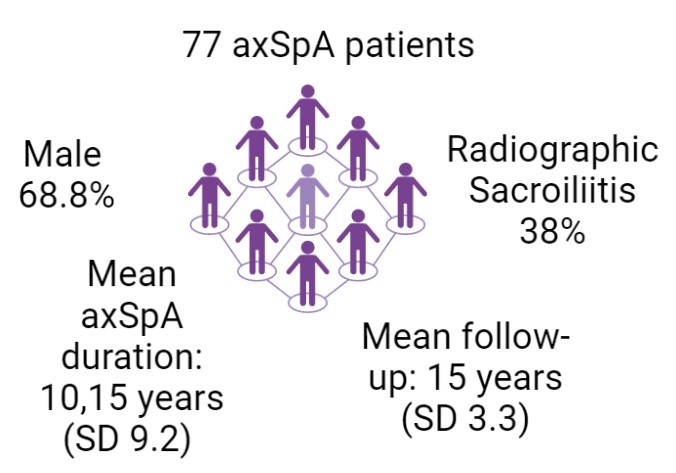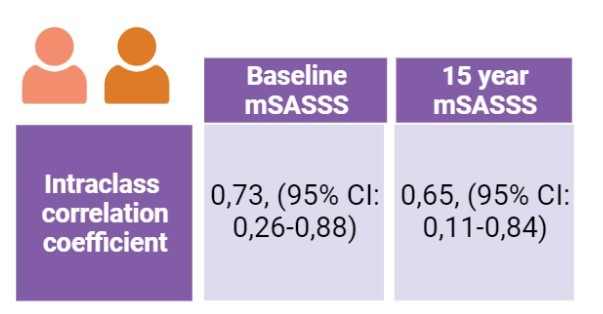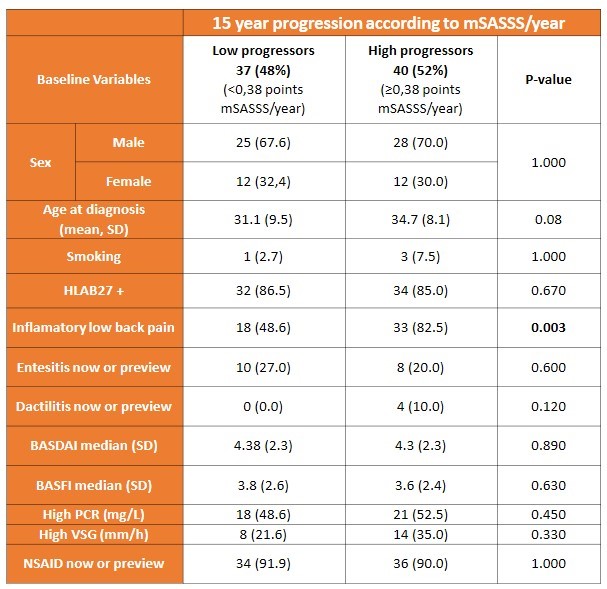Session Information
Session Type: Poster Session B
Session Time: 9:00AM-11:00AM
Background/Purpose: Axial spondyloarthritis (axSpA) is characterized by progressive structural damage on the sacroiliac joints and/or the spine. Conventional radiology allows to assess radiology through available scales such as the mSASSS (modified Stoke Ankylosing Spondylitis Spinal Score) in the spine. However, scarce is the data on long-term radiographic progression and factors associated with such progression. The aim of this study was to evaluate the radiographic progression in the spine in patients with axSpA after a mean of 15 years of follow-up as well as the factors associated with such progression.
Methods: Patients with axSpA pertaining to the Reina Sofia University Hospital and included in the multicentre Spanish registry REGISPONSER between 2006-2007 were re-evaluated in 2021-2022. Spine (cervical and lumbar) radiographs were obtained with the aim to be compared with those obtained in 2007. Two trained blinded readers scored the mSASSS in radiographs from both visits (baseline and current). First, intraclass correlation coefficients (ICC) were obtained to evaluate the agreement between both readers in mSASSS. Mean mSASSS of both readers in both timepoints were calculated and the absolute progression (∆mSASSS) was evaluated. In addition, it was evaluated the mean and median progression per year dividing the ∆mSASSS by the years of follow-up in each patient. Then, the median progression per year was used to divide patients in “low progressors” and “high progressors”. Baseline characteristics between these two groups were compared using univariate analysis.
Results: A total of 77 axSpA patients with both baseline and current radiographs were included. A total of 53 (68.8%) were male and the mean disease duration was 10.15 (SD 9.2) years. All of them were naïve to bDMARD at baseline and 38% had radiographic sacroiliitis. The mean years of follow-up (i.e, mean time separating the radiographs) was 15 years (SD 3.3) (Figure 1). ICC between the two readers was moderate for mSASSS at baseline (0.73, 95%CI 0.26-0.88) and at the 15 years visit (0.65, 95%CI 0.11-0.84) (Figure 2). After a mean of 15y of follow-up, the mean progression was 0.54 (SD 0.55) points in mSASSS per year and the median progression was 0.38 points per year. A total of 37 (48%) patients were considered “low progressors” (i.e., median progression < 0.38 points per year) and 40 (52%) were considered as “high progressors” (i.e., median progression ≥0.38 points per year). The only significant variable associated with “high progression” was low back pain before the diagnosis (82.5% vs. 48.6%, p-value 0.003). Neither sex, smoking, disease duration, HLAB27 or c-reactive protein were associated with the “high progression” group (Table 1).
Conclusion: In this stablished axSpA population, the mean and median progression were 0.54 and 0.38 points in mSASSS per year respectively, which is lower than what has been reported in similar cohorts (i.e., change in 2 points per two years in mSASSS). Only low back pain was found as predictor of spinal radiographic progression.
To cite this abstract in AMA style:
granados r, Dans-Caballero S, Ladehesa Pineda L, Puche Larrubia M, Ruiz Vilchez D, Abalos-Aguilera M, Escudero-Contreras A, Collantes Estévez E, López Medina C. Low Spinal Radiographic Progression After a Mean of 15 Years of Follow-up in a Cohort of Patients with Axial Spondyloarthritis [abstract]. Arthritis Rheumatol. 2023; 75 (suppl 9). https://acrabstracts.org/abstract/low-spinal-radiographic-progression-after-a-mean-of-15-years-of-follow-up-in-a-cohort-of-patients-with-axial-spondyloarthritis/. Accessed .« Back to ACR Convergence 2023
ACR Meeting Abstracts - https://acrabstracts.org/abstract/low-spinal-radiographic-progression-after-a-mean-of-15-years-of-follow-up-in-a-cohort-of-patients-with-axial-spondyloarthritis/



